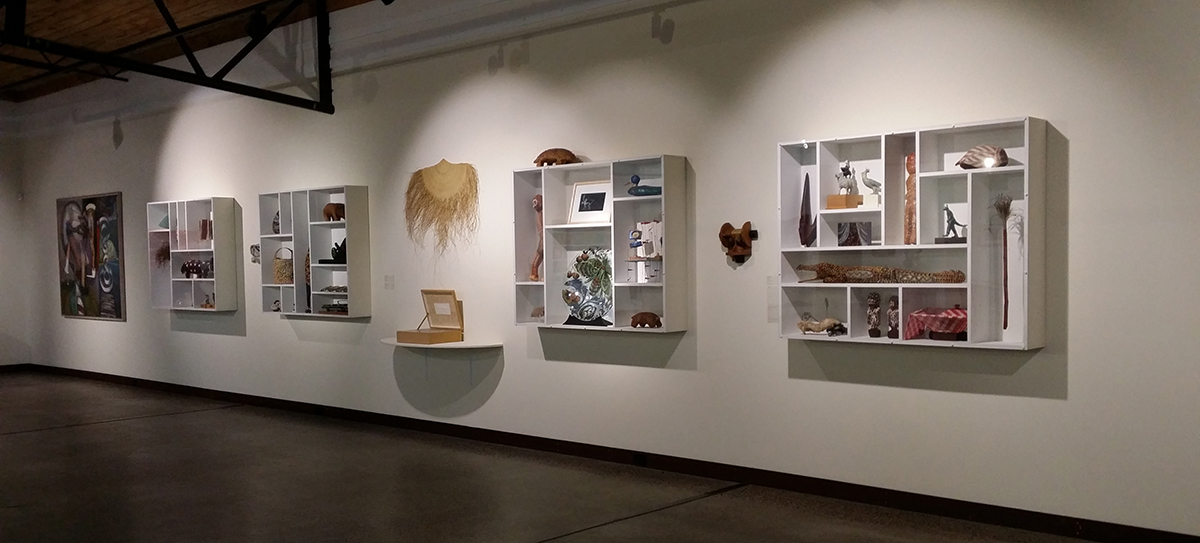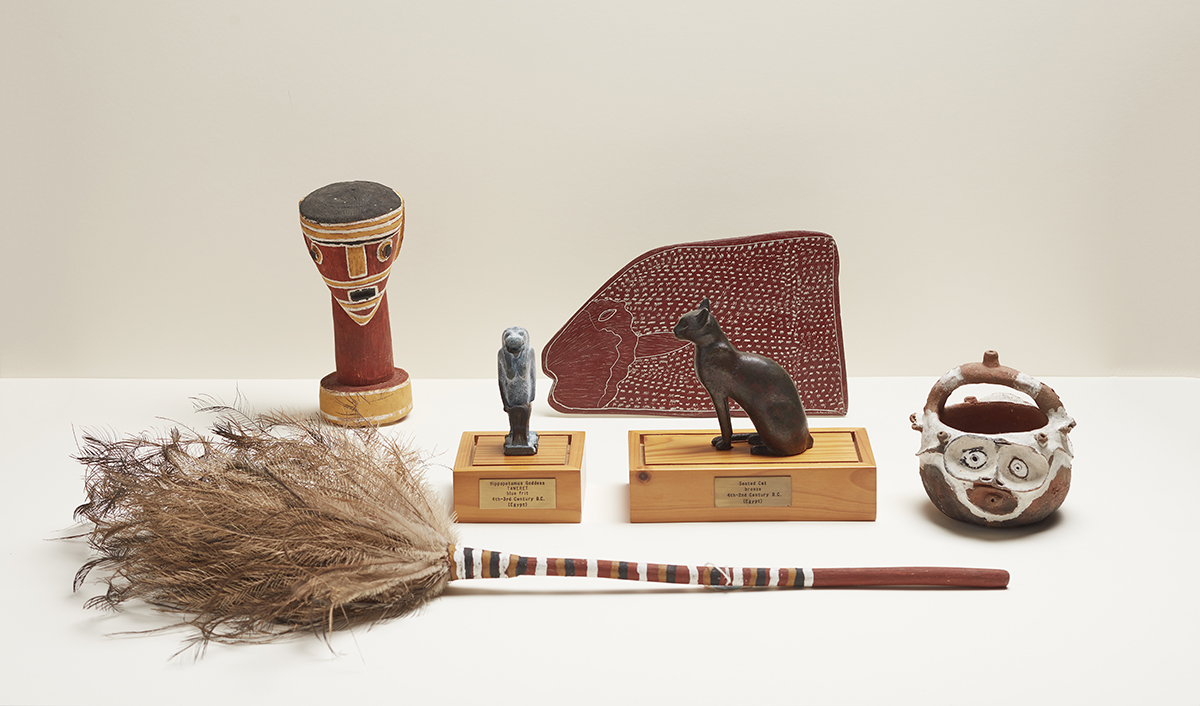Objectillogica: a modern wunderkammer, curated by Megan Schlipalius, is an exhibition based on the cabinet of curiosity fetish of the past. This exhibition is thematically anchored in Eurocentric history but looks to the more recent past of Australia’s colonisation and the curiosities of the Holmes à Court collection, presented at Vasse Felix winery, a striking piece of architecture in the rambling countryside of Margaret River. Paintings and objects are clustered across the walls, sculptures adorn the floor and several glass-fronted, custom-built cabinets house a diversity of treasures, from carved animals to woven hair and feathers and bronze sculptures.
The Wunderkammer of the 16th to the 18th centuries was a prodigious source of inspiration for the noble classes. It was a way of knowing the world, an expression of power, as though the collections of taxidermied animals, fossils, relics, shells, artworks and other artefacts could offer a portal into far flung exotic places. It was also an early expression of colonial ideology. As writer Ian McLean observed in 2010, “The taxonomies displayed in its rooms and cabinets were imagined as micro-scenes of the world. They are amongst the first fruits of a new world founded on European colonial expansion and mercantile acumen of global reach, and signal a burgeoning desire to not just re-order the cosmos but to know, own and control it.”
As such, the Wunderkammer was also an early expression of Enlightenment thinking. It projected forwards, as much as it looked back to the past through the collection of ancient objects. Today there are contradictions inherent within the idea of the Wunderkammer, for while it was once taken so seriously, as a method of categorising, understanding and containing otherness, it is presently viewed as an odd and whimsical pastime for those who had too much time on their hands. In another guise it has also infiltrated contemporary art and Wunderkammering, a term dubbed by McLean, is a curatorial and artistic strategy of mixing, matching and clashing together objects from different times. It fits well within a postmodern and post-colonial logic and over the past decade there has been something of a revival of Wunderkammer exhibitions and their critical evaluation within the Australian context, including Curious Colony: a Twenty First Century Wunderkammer at Newcastle Regional Gallery in 2010 and Wunderkammer: The strange and the curious, at UQ Art Museum in 2015.

Installation shot of Objectillogica, photo by Megan Schlipalius
Sourced entirely from the Holmes à Court private collection, Objectillogica subtly unfolds and brings together a selection of Indigenous, non-indigenous, colonial and contemporary works dating from 300BC to 2014. Despite the Wunderkammer originally being a kind of proto-museum of contemporary museums, Schlipalius told me by email that “the arrangement of works was mainly inspired by the notion of an anti-museum. This approach was initially inspired by MONA’s Theatre of the World — although at a much more modest scale! I attempted to put disparate objects next to each other while creating a visual balance throughout the cabinets.” The MONA connection is significant, as David Walsh’s institution is also founded on antagonism to the usual museological conventions of display and curation.
Likewise, Objectillogica is an anti-museum in that it eschews the traditional taxonomic systems of museums and early curiosity cabinets. This exhibition is also in tension with the minimalist hangs of many contemporary art displays, instead pushing to fill all available space and, rather than being arranged according to similitude or taxonomic rigidity, there are thematic currents running through the show that make it compelling as well as cohesive. What is taken from MONA’s Theatre of the World is the Wunderkammering approach of mixing ancient, modern and contemporary, artefact and art and, rather than drawing from all reaches of the globe, it is largely located in the Australian and primarily Western Australian contexts.

Unknown artists from the Kimberley region, Egypt and Papua New Guinea, photo by Robert Frith, Acorn Photography
The show considers a specifically Australian ‘wonder,’ where it is apparent that the collecting process, by Holmes à Court, has been driven by a keen eye for the historically significant, culturally relevant and occasionally obscure. There are exquisite works of art on display here and the obscure has been brought to the forefront in keeping with the traditional Wunderkammer, as a way to reveal and revel in the curious. At the entrance is a linocut by Rew Hanks titled The Hunter and the Collector. It features botanist Joseph Banks surrounded by a plethora of objects that relate specifically to Banks, such as Banksia flowers, May Gibbs’ wicked Banksia Men and the prickly pear weed introduced by Banks. At his feet is an image of the jar containing the head of Pemulwuy, the Indigenous warrior resistant to colonisation whose head was reportedly sent to Banks in England. This image critiques colonial attitudes and makes evident the damage wreaked on ‘new worlds.’
This is where the relevance lies in presenting a Modern Australian Wunderkammer. Like a transhistorical lesson, it offers ways to rethink events of the past and reconsider our place in the world; there is revelatory strength in mixing old and new. This makes it serious business, with biting political commentary, but there are also currents of humour running through this interpretation. There is the obligatory crocodile, in this case Francella Tungaltalum’s Yirrikapai (The Saltwater Crocodile), in a nod to museological tradition. There is a toolkit made entirely of extruded plastic by the artist Eamon O’Toole. The Wunderkammer presented here is still a way of knowing the world, of teasing out the idiosyncrasies of the local and national context with all its inherent layers of meaning and playfulness.
–
Objectillogica – a modern wunderkammer, curator Megan Schlipalius, Holmes à Court Gallery at Vasse Felix, Cowaramup, WA, 21 May-1 Oct
Top image credit: Danie Mellor, Hunter Gatherer, 2008, mixed media with shopping trolley, image courtesy the artist



